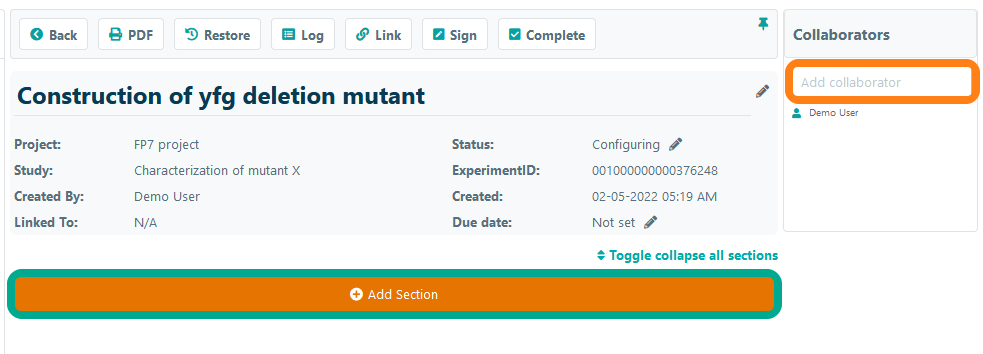Quick Start Guide
- To get started in the Shared Cloud, you can sign up for an eLabJournal free trial here.
- After completing registration, you will receive an email to activate a new account.
- Once your account has been activated, you can login here

Enter the email address used to register your account and your password to log in. Note: If organisation login is active for your organisation (SAML/LDAP/AD), please use the institute login option. Note that if your organisation has a dedicated installation of the eLabJournal Private Cloud or eLabJournal On-Premise, the links for the account registration and login is different. Please contact the key-user in your organisation for the correct URLs.
Create or Join a Group
After setting up your account, you will first need to set up a group in which you can organize and share data. A group is a secure environment for your lab, research group, or department within an academic institute or company where uses can collaborate on projects. If your lab is already using eLabJournal, you can ask your group administrator to invite you to join an existing group.

Set up Electronic Lab Notebook
In eLabJournal, experiments are organized by project. Projects organize a collection of studies, which, in turn, organize a collection of experiments. Once you have defined a project and study in the Experiment Browser, you can start adding experiments. Read tips and tricks on how to organize projects and studies in the Best Practices User Guide.

An experiment can be considered a blank page of a traditional handwritten lab notebook with added features. You can visually log data in the experiment by adding sections. There are sections to add text, samples, protocols, images, excel files, drawings, and raw data files. By adding collaborators to an experiment, you will be able to work on the experiment together with other members of your team and easily share lab results.

Set up protocol templates
Within eLabJournal, you can set up protocols or standard operating procedures (SOPs). Protocols can be inserted to experiments to standardize how they should be carried out, thereby increasing their reproducibility. Protocols support dynamic fields (variables and formulas) that can be adjusted with just a few mouse-clicks when adding them to an experiment. Frequently used protocols are published in the Public repository in the Procedures menu and can be copied for personal use.

Invite Lab Members and set Permissions
Once you have completed the basic system configuration, you are ready to invite your co-workers to join your lab and start tracking their lab results. If your lab is not yet licensed, please contact us to activate a 30-day, no-obligation, free trial for your lab.

Once lab members are signed up, you can set permissions for each user by changing the user role. For each role, you can define permissions with respect to viewing, adding, updating and deleting projects, studies, experiments, protocols, and samples. For example, permissions may be configured so that users can only view, update, or delete their own samples, but not those of other users.

Additional Configuration Options
Supplies and Stock Management
Set up a central product catalogue that allows lab members to easily (re)order chemicals and consumables as they are used in the lab. If you enable the quantity-tracking feature, items can automatically be added to the lab shopping list when the stock falls below a certain threshold. The lab manager can collect and approve orders periodically to centralize ordering within the lab. Please contact us to activate supplies ordering for your lab.
Equipment monitoring and booking
Set up equipment in the lab to monitor periodic maintenance, schedule validation events, or centralize equipment bookings through the device's planner. Use the eLabJournal Mobile App to see when a device is available and create an immediate booking for your experiment.
Sample Barcode Labelling
Install a your a supported lab printer and activate the corresponding add-on in our Marketplace to print barcode labels for your samples. Label your tubes and access all sample information by scanning the 2D QR code with the eLabJournal Mobile App.
Experiment Templates
Standardize the format of your electronic lab notebook layout by setting up template for experiments or even entire workflows. Once you have created a template, you can select it as the basis for new studies. As a group leader or supervisor, you can easily ensure that all experiments are executed following the same steps and all required data is collected.
Project Groups
Projects can be further organized into project groups. A project group adds an extra level to the experiment browser to organize projects. Add users to a project group and adjust the collaboration setting to automatically give all users in the project group access to a project. You can also set up a project group to collaborate and share data with members of other labs.